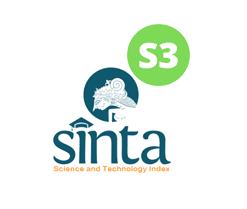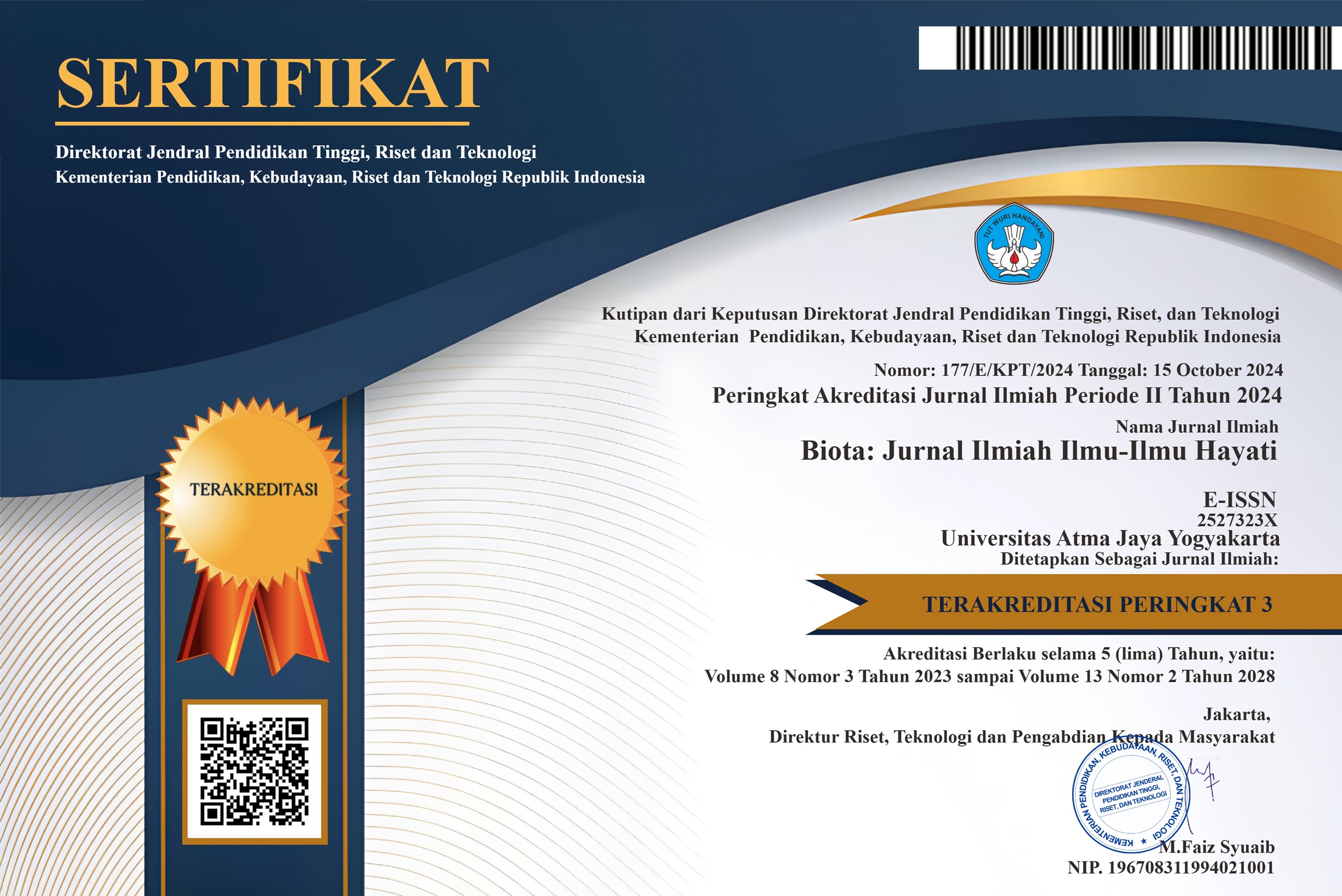Effect of the Type of Organic Waste and Retention Time on Biogas Production from Cow Dung
DOI:
https://doi.org/10.24002/biota.v5i3.3682Keywords:
Biofuel, biogas, anaerobic digestion, renewable energy, organic waste, retention timeAbstract
Nowadays, the demand on fossil energy is increasing in number whereas its availability is decrease. People are still reckoned on it, despite of its rareness. Fossil energy utilized must be banned due to its negative effect. It is time for us to use renewable and eco-friendly energy (biofuel). Biogas is one of biofuel produced from anaerobic decomposition of organic matter by microorganisms. Organic waste as a by-product of our daily activities can be used as raw material to produce biogas. To use waste, means to decrease the environmental pollution problem. This research is aim to study the type of organic waste as a raw material to produce biogas through anaerobic digestion and its retention time. Organic wastes that were used in this research are domestic waste (food waste), agriculture waste (corn leaves) and industrial waste (solid and liquid waste of tofu). All of these wastes were mixed with cow dung as the starter/inoculum. As a control, the starter was used without organic waste addition. The testable retention times were 1st week until 9th week. The experimental design was Factorial Complete Randomized Design with confidence level 95%. The result showed that all the type of organic waste can be used to produce biogas through anaerobic digestion. Statistically, the average volume of biogas produced from industrial waste per week, 5794,3 ml was significantly different from any other organic waste (P=0,000). The best retention time was found on 8th week with the average volume of biogas was 3675,6 ml (P=0,006). There was no interaction between these two factors (P=0,1). This research is expected to open the people’s awareness about the management of useable organic waste as a raw material to produce biogas.
References
Abimbola, O. O., & Osokoya, O. O. (2014). Evaluation of Biogas Production from Food Waste. The International Journal Of Engineering And Science (IJES), 3(01), 1–7.
Adamu, A. (2015). Effect of Substrate on Biogas Yield. Global Journal of Engineering Research, 13(1), 35. https://doi.org/10.4314/gjer.v13i1.4
Ahamed, J. U., Hossain, Md. S., Rahman, M. M., & Salam, B. (2016). Production of Biogas from Anaerobic Digestion of Poultry Droppings and Domestic Waste using Catalytic Effect of Silica Gel. International Journal of Automotive and Mechanical Engineering, 13(2), 3503–3517. https://doi.org/10.15282/ijame.13.2.2016.17.0289
Aknesa, S. (2018, October 3). Produksi Biogas Dari Campuran Tongkol Jagung (Zea mays L.) Dengan Kotoran Sapi [Skripsi]. FAKULTAS PERTANIAN. http://digilib.unila.ac.id/33683/
Anggito, T. A. (2014). Studi Pembangkitan Energi Listrik Berbasis Biogas [Masters, Univeritas Pendidikan Indonesia]. http://repository.upi.edu
Awe, O. W., Zhao, Y., Nzihou, A., Minh, D. P., & Lyczko, N. (2017). A Review of Biogas Utilisation, Purification and Upgrading Technologies. Waste and Biomass Valorization, 8(2), 267–283. https://doi.org/10.1007/s12649-016-9826-4
Chairani, S. (2014). Anaerobik Co-digesi LimbahTanaman Jagung (Zea mays) dan Digested Manure Sapi Terhadap Peningkatan Produksi Biogas Sebagai Energi Terbarukan dengan Menggunakan Reaktor Mesophilic. Prosiding Seminar Nasional PERTETA dan HIPI, 10.
Cristobal, A. D. L., Inocencio, J. E. C., Leyson, A. L., Mendiola, C. A. D., & Nicolas, J. E. (2019). The Effectiveness of Generating Electricity from Biogas Created from Food Wastes With the Use of Peltier Diode as A New Source of Renewable Energy. Renewable Energy, 3.
Herlambang, A. (2002). Teknologi Pengolahan Limbah Cair Industri Tahu. Pusat Pengkajian dan Penerapan Teknologi Lingkungan (BPPT) dan Bapedal. http://www.kelair.bppt.go.id/Publikasi/BukuLimbahCairIndustri/02tempe.pdf
Iriani, P., Suprianti, Y., & Yulistiani, F. (2017). Fermentasi Anaerobik Biogas Dua Tahap Dengan Aklimatisasi dan Pengkondisian pH Fermentasi. Jurnal Teknik Kimia dan Lingkungan, 1(1), 1. https://doi.org/10.33795/jtkl.v1i1.16
Kamal, N. (2019). Kajian Pengaruh Media Penambat Pada Reaktor Biogas Fluidized Bed. Jurnal Teknologi, 1(33), 22.
Kementerian ESDM Indonesia. (2013). Kajian Supply demand energy. Pusat Data Teknologi Informasi Energi dan Sumber Daya Mineral.
Kompas Cyber. (2011). Bahan Bakar Fosil Habis 30 tahun Lagi. KOMPAS.com. https://money.kompas.com/read/2011/07/27/20141288/Bahan.Bakar.Fosil.Habis.30.tahun.Lagi
Madigan, M. T., Martinko, J. M., Bender, K. S., Buckley, D. H., & Stahl, D. A. (2015). Brock Biology Of Microorganisms (14th ed.). Pearson Education, Inc.
Marsudi, M. (2012). Produksi Biogas dari Limbah Rumah Tangga sebagai Upaya Mengatasi Krisis Energi dan Pencemaran Lingkungan. Turbo : Jurnal Program Studi Teknik Mesin, 1(2). https://doi.org/10.24127/trb.v1i2.650
Mirmohamadsadeghi, S., Karimi, K., Tabatabaei, M., & Aghbashlo, M. (2019). Biogas Production from Food Wastes: A Review on Recent Developments and Future Perspectives. Bioresource Technology Reports, 7, 100202. https://doi.org/10.1016/j.biteb.2019.100202
Morales-Polo, C., Cledera-Castro, M. del M., & Soria, B. Y. M. (2019). Biogas Production from Vegetable and Fruit Markets Waste—Compositional and Batch Characterizations. Sustainability, 11(23), 6790. https://doi.org/10.3390/su11236790
Ni’mah, L. (2014). Biogas from Solid Waste of Tofu Production and Cow Manure Mixture: Composition Effect. CHEMICA: Jurnal Teknik Kimia, 1(1), 1. https://doi.org/10.26555/chemica.v1i1.500
Nisrina, H., & Andarani, P. (2018). Pemanfaatan Limbah Tahu Skala Rumah Tangga Menjadi Biogas sebagai Upaya Teknologi Bersih di Laboratorium Pusat Teknologi LIngkungan. Jurnal Presipitasi : Media Komunikasi dan Pengembangan Teknik Lingkungan, 15(2), 139. https://doi.org/10.14710/presipitasi.v15i2.139-140
Purnomo, A., & Mahajoeno, E. (2010). Produksi Biogas dari Limbah Makanan melalui Peningkatan Suhu Biodigester Anaerob. Proceeding Biology Education Conference: Biology, Science, Enviromental, and Learning, 7(1), Article 1. https://jurnal.uns.ac.id/prosbi/article/view/5980
Ridhuan, K. (2016). Pengolahan Limbah Cair Tahu Sebagai Energi Alternatif Biogas yang ramah lingkungan. Turbo : Jurnal Program Studi Teknik Mesin, 1(1). https://doi.org/10.24127/trb.v1i1.81
Ritonga, A. M., & Masrukhi, M. (2017). Optimasi Kandungan Metana (CH4) Biogas Kotoran Sapi Menggunakan Berbagai Jenis Adsorben. Jurnal Rona Teknik Pertanian, 10(2). https://doi.org/10.17969/rtp.v10i2.8493
Subekti, S. (2011). Pengelolaan Limbah Cair Tahu Menjadi Biogas sebagai Bahan Bakar Alternatif. Prosiding Seminar Nasional Sains dan Teknologi ke-2 Fakultas Teknik Universitas Wahid Hasyim Semarang. Seminar Nasional Sains dan Teknologi ke-2 Fakultas Teknik Universitas Wahid Hasyim Semarang, Semarang.
Suyitno, S., Sujono, A., & Dharmanto, D. (2010). Teknologi Biogas: Pembuatan, Operasional dan Pemanfaatan. Graha Ilmu.
Tsai, D. D.-W., Ramaraj, R., & Chen, P. H. (2016). Carbon Dioxide Bio-Fixation by Algae of High Rate Pond on Natural Water Medium. Ecological Engineering, 92, 106–110. https://doi.org/10.1016/j.ecoleng.2016.03.021
Utami, A. R. I., & Muntini, M. S. (2010). Analisis Peran Limbah Cair Tahu dalam Produksi Biogas. Seminar Nasional X Pendidikan Biologi FKIP UNS. Seminar Nasional X Pendidikan Biologi FKIP UNS, Surakarta.
Wahyuni, S. (2013). Panduan Praktis Biogas. Penebar Swadaya Grup.
Downloads
Published
How to Cite
Issue
Section
License
Copyright (c) 2021 Oktavius Yoseph Tuta Mago, M A Yohanita Nirmalasari, Agustina Dua Kuki, Yohanes Nong Bunga, Aljefridus Misa

This work is licensed under a Creative Commons Attribution-NonCommercial 4.0 International License.
Authors who publish with Biota : Jurnal Ilmiah Ilmu-Ilmu Hayati agree to the following terms:
- Authors retain copyright and grant the Biota : Jurnal Ilmiah Ilmu-Ilmu Hayati right of first publication. Licensed under a Creative Commons Attribution-NonCommercial 4.0 International License that allows others to share the work with an acknowledgment of the work's authorship and initial publication in this journal.
- Authors are able to enter into separate, additional contractual arrangements for the non-exclusive distribution of the journal's published version of the work (e.g., post it to an institutional repository or publish it in a book), with an acknowledgment of its initial publication in Biota : Jurnal Ilmiah Ilmu-Ilmu Hayati, and as long as Author is not used for commercial purposes.













